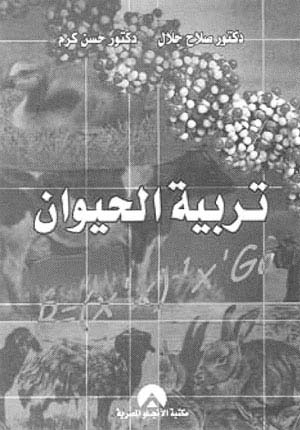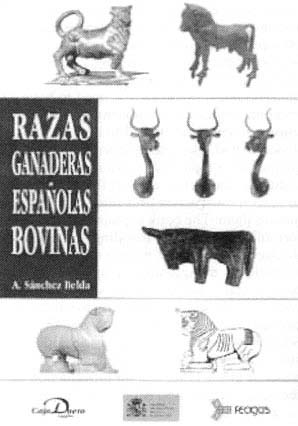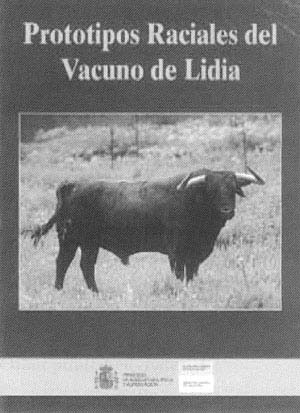Animal Breeding
S. Galal & H. Karam
6th Edition (In Arabic)
AngloEgyptian, Cairo, Egypt
Published in 2002, ISBN: 977-298-249-8
pp. 350
The first edition of the book appeared in 1968. The book, paper back, is suitable as a text for the undergraduate students majoring in Animal Production and as an introduction to graduate courses. The 6th edition includes 11 chapters and two annexes. The chapters cover the range of quantitative genetics and its application in animal breeding, i.e. gene frequency, causes of phenotypic variation, estimation of phenotypic, additive, dominance, epistatic and environmental variances, measuring the relationship between individuals, selection and selection indices, estimation of breeding value including BLUP, mating systems and biotechnology. Realizing the need to have a breeding infrastructure for any genetic improvement to occur and to be disseminated, the authors devoted a full chapter on a topic called Animal Breeding Industry where they explain the components of such infrastructure and inter-relationships among them. The book explains in details the formulation of animal breeding strategies through selection and mating systems. The text follows the quantitative approach and has got many solved examples and problems with answers at the end. It has extensive and updated list of relevant references and a Subject Index. The two annexes include statistical tools needed to understand the material in the book and an introduction to the basics of genetics. All technical expressions are given both in Arabic and English. The book is recommended for Arabic speaking undergraduate and graduate students majoring in Animal Breeding, instructors and enlightened animal breeders willing to understand the quantitative approach in animal genetic improvement.

Razas ganaderas Españolas bovinas
(Spanish cattle breeds)
A. Sánchez Belda, FEAGAS, Ministerio de Agricultura, Pesca y
Alimentación (Eds) (In Spanish)
Published in 2002, ISBN: 84-491-0535-8
pp. 358
In the 1980’s the Ministry of Agriculture edited the Catalogues of the Spanish Autochthonous Bovine, Ovine and Caprine Breeds. Those publications had a great success among the professionals related to livestock production. After 20 years, the Spanish Federation of Selected Breeds Breeder’s Associations (FEAGAS), together with the Ministry of Agriculture, have reviewed and updated the information related to bovine breeds that is included in the present publication.
This publication, in hard cover, summarises the status of both the bovine autochthonous breeds and those breeds which were introduced in Spain and exploited in the country during more than 30 years and that now are part of our selection livestock.
The objective of this publication is to describe the present situation of each breed in the context of its own environment and production system. Morphological and productive characteristics of the breeds are described, including data on the origin, production systems, distribution in the country and breeding programmes applied. Two chapters devoted to traditional handling of bovine in Spain (“cabestraje” and transhumance) are included at the end of the book.
It is necessary to underline the important role that autochthonous breeds have traditionally played in Spain, and the major role that they can also play today, both from the economic, social and environmental points of view, providing a variety of quality products and contributing to a sustainable rural development.
This publication has been created with the full collaboration of the different Breeder's Associations, officially recognised in Spain.

Performance recording of animals - State of the art, 2002
J. Crettenand, J. Moll, C. Mosconi & S. Wegmann
Proceedings of the 33rd Biennial Session of ICAR,
Interlaken, Switzerland, May 26 - 31, 2002
EAAP publication no. 107
Published in 2003, ISBN 9076998167
pp. 363
This hard cover publication represents the Proceedings of the 32nd Biennial Session of the International Committee for Animal Recording (ICAR) and Interbull Meeting held in Interlaken, Switzerland on 26-31 May 2002.
Around 400 participants from 60 countries took part in the ICAR Session or attended the Interbull Meeting. The activities were divided into five parallel technical sessions. Overall, about 40 technical papers and reports were presented during the sessions. A technical session was especially devoted to the presentation of the activities of the Task-Forces, Sub-Committees and Working Groups in which a total of 19 reports were presented.
Issues discussed covered the use of new technologies for animal performance recording, the application of national animal tracing databases, the use of data from permanent milk recording for official performance recording, the performance recording of beef traits and possible alternative systems of recording of functional traits.
Particularly relevant was also the involvement of representatives of non-member organizations, especially from Central and Eastern Europe and developing countries, whose needs demonstrate the possibilities that could be offered by ICAR to help the (re)organization of the animal sector in these countries. The Sessions allowed an active exchange of ideas and experiences among the participants who recognized that the dialogue is an effective engine for improvement.
Considering that the resources of most member organizations have been reduced, the need of working together was strongly underlined, today more than in the past, in order to achieve common objectives.

Conservation of genetic diversity: Assessing genetic variation
using marking estimated kinships
H. Eding (Ed.)
Animal Breeding and Genetics Group, Department of Animal Sciences,
Wageningen University, P.O. Box 338, 6700 AH Wageningen, The Netherlands.
Published in 2002 ISBN: 90-5808-556-2
pp. 119
This publication, in paper back, focuses on assessing genetic diversity in a quantitative way through the use of Malecots coefficients of kinship. Kinships between and within populations and individuals can be estimated using microsatellite marker genes that are assumed to be selectively neutral. Genetic diversity is estimated from such Marker Estimated Kinships (MEK) by [1 - average (MEK)], where genetic diversity of a set of breeds is defined as the maximum genetic variation in a population that can be bred from this set of breeds. The concept of core sets is applied to livestock genetic diversity and a new measure of genetic diversity present in a set of breeds, is developed.
These general problems are discussed by the Author in the first chapter while Chapter 2 deals with estimating kinships between and within populations and individuals using microsatellite marker genes that are assumed to be selectively neutral. The argument for the use of kinships in genetic diversity studies as opposed to the use of genetic distances and related measures is also developed in this chapter.
Chapter 3 introduces the concept of core sets applied to livestock genetic diversity and a new measure of genetic diversity present in a set of breeds, based on the mean kinship within a core set, is developed.
Chapter 4 compares a number of methods to simultaneously estimate kinships and the probability for alleles alike in state (AIS) with regard to their accuracy and robustness, especially when the kinship matrix is not properly constructed due to error variance of the kinship estimates. The latter leads to populations that have incorrectly received a null-contribution. The methods are compared using simulated data.
Chapter 5 describes the analysis of a data set concerning African cattle populations, using the methods developed in the previous chapters. Effects of conservation by breed type or regional versus continental conservation are examined, in terms of efficiency of conservation.
Chapter 6 presents the results described in the previous chapters.

Le races bovines au Maroc
(Cattle breeds in Morocco)
I. Boujenane (Ed.) (In French)
Actes Édition, Institut Agronomique et Vétérinaire
Hassan II,
B.P 6202-Institut, 10101 Rabat, Maroc
Published in 2002, ISBN: 9981-801-52-6
pp. 144
After the set-up of the “Milk Production Plan” established in 1975 and the “Meat Production Plan” in 1978, the cattle sector of Morocco has been submitted to a continuous development to the detriment of the local cattle breeds.
The aim of this publication, in paper back, is to establish the real knowledge of local Animal Genetic Resources (AnGR) and present their productive characteristics. Autochthonous cattle breeds are clearly presented; their colour pictures are shown, together with their breeding tracts and production systems, strictly linked to local populations and their traditions.
The value of the local cattle breeds (mainly the Brune de l’Atlas, Oulmès-Zaer, Noir-Pie de Meknès, Tidili) is herewith summarised and the reasons for their conservation analysed.
Particularly important is the chapter that describes the cattle pure breeds and the breeding schemes planned in Morocco. The final chapter summarises the economic relevance of the cattle sector in the country.
This small volume is particularly interesting to those who wish to have a clear picture of the cattle sector in Morocco. It has the merit of presenting the work carried-out in the country, that is specifically related to conservation of local AnGR and genetic improvement of imported breeds. All the efforts of the Moroccan Ministry of Agriculture, who is responsible for these actions, aimed at the development of a sustainable meat and milk production system in the country.

L'Observatoire des systèmes de production ovine et
caprine en Méditerranée
The monitoring body on sheep and goat production systems in the Mediterranean
Options Méditerranéennes Série B/No. 39
J.-P. Dubeuf (Ed.)
Mediterranean Agronomic Institute of Zaragoza,
Apdo. 202, 50080 Zaragoza, Spain
Published in 2002, ISSN: 1016-1228; ISBN: 2-85352-242-3
pp. 157
Sheep and goat production systems are undergoing profound and rapid changes throughout the Mediterranean region.
In order to satisfy the important information needs of the small ruminant sector, the FAO-CIHEAM Network on Sheep and Goats set up the Monitoring Body on Sheep and Goat Production Systems in 1994. This Body has established an information collection and processing system coordinated by the Centre International de Ressources et de Valorisation de l'Information des Filières Laitières Petits Ruminants (CIRVAL) and has developed a methodology to share data and calculate indexes to compare production areas.
This initiative has improved since then, and this publication includes the works of the Monitoring Body on Sheep and Goat Production Systems up to date.
The summarised activities include:
1. A well-defined and rigorous methodology: a collection of common comparative indicators has been set up to work on data of different origins and qualities.
2. Various diffusion activities: publication of a CD, meetings and seminars, internet fora, local awareness, etc.
3. Definition of target persons and specific objectives: in this case it refers to regional and national experts and professionals from extension services of the sheep and goat regions and sectors in the Mediterranean.
4. Continuous effort and participation of the members. Thus, a motivated working group with members from many different regions has been set up.
This work could help to clarify and revitalize local projects by strengthening information systems in each region. There is still a lot to be done, like extending the action of the Monitoring Body to the southern part of the Mediterranean. The papers in this publication are in English, Spanish and French

Prototipos raciales del vacuno de lidia
(Breed prototype of bull-fighting)
Ministerio de Agricultura, Pesca y Alimentación (Ed.) (In Spanish)
Centro de publicaciones, Paseo de la Infanta Isabel, 1 - 28014 Madrid,
Spain
Published in 2002, ISBN: 84-491-0537-4
pp. 270
The Spanish fighting bull originates from the Middle Age in Spain. It is characterized by its aggressiveness and resistance to conventional handling. The breed is exploited in extensive system. It has a great adaptability to almost any ecosystem in Spain and exerts a beneficial effect on them due to its compatibility with the local flora and fauna.
The Spanish fighting bull is one of the most valuable contribution to the world of animal production. It is a unique breed worldwide and the great protagonist of the Fiesta, which makes its existence possible. Independently of the individual opinion on the Fiesta, the Spanish fighting bull has a very important socio-economic and environmental role that has to be taken into account.
The special selection applied to this breed, which is entirely in the hands of each individual breeder through successive generations, has lead to the existence of different varieties, otherwise called “encastes”, that are morphologically identifiable and some of which are in danger of extinction.
This publicacion, in paper back, reviews the various “encastes” through their origins, the morphological and ethological characteristics and summarises their present situation.
In the introduction, the variety of morphological characteristics that the Spanish fighting bull can show are briefly described.
